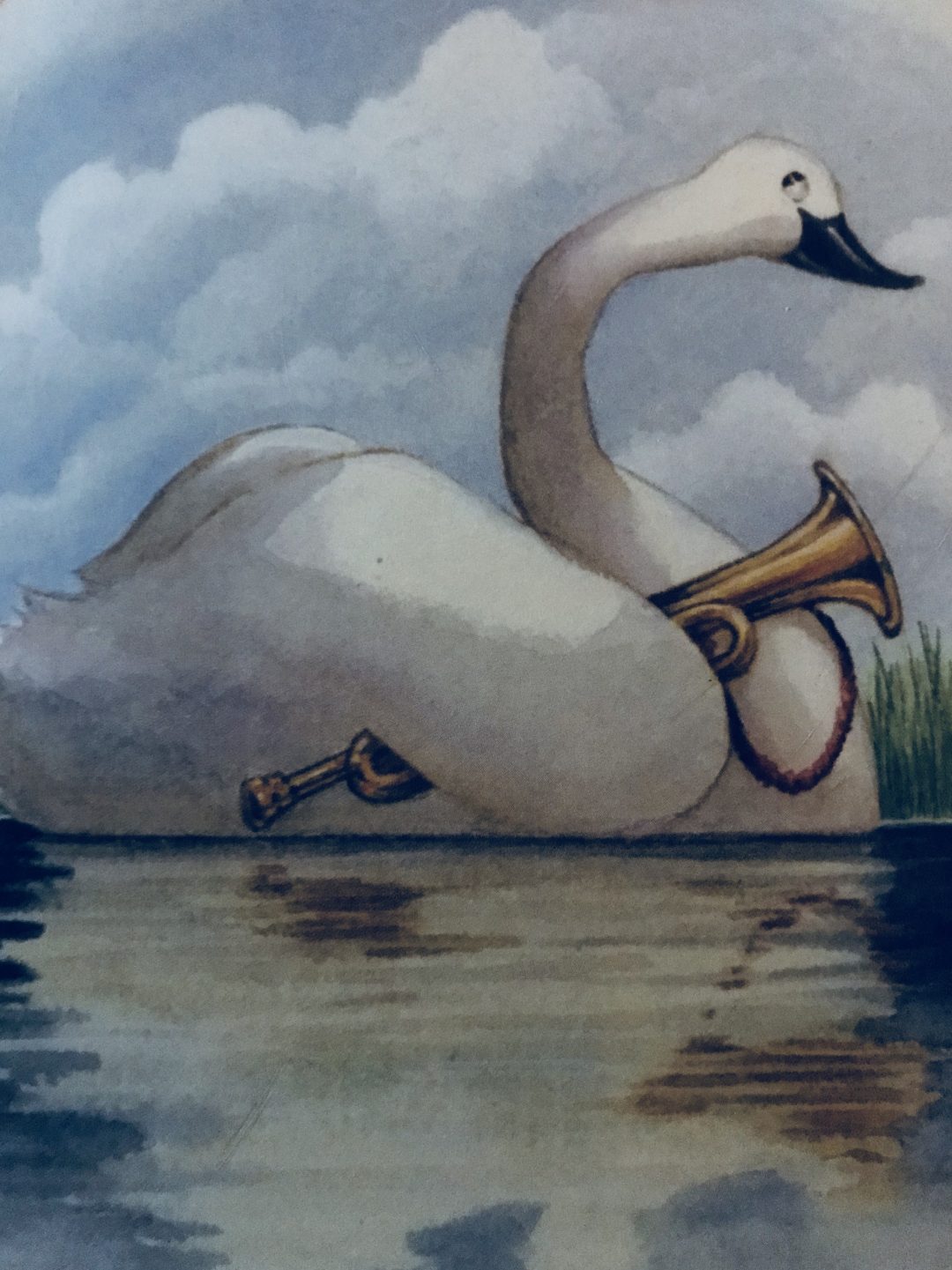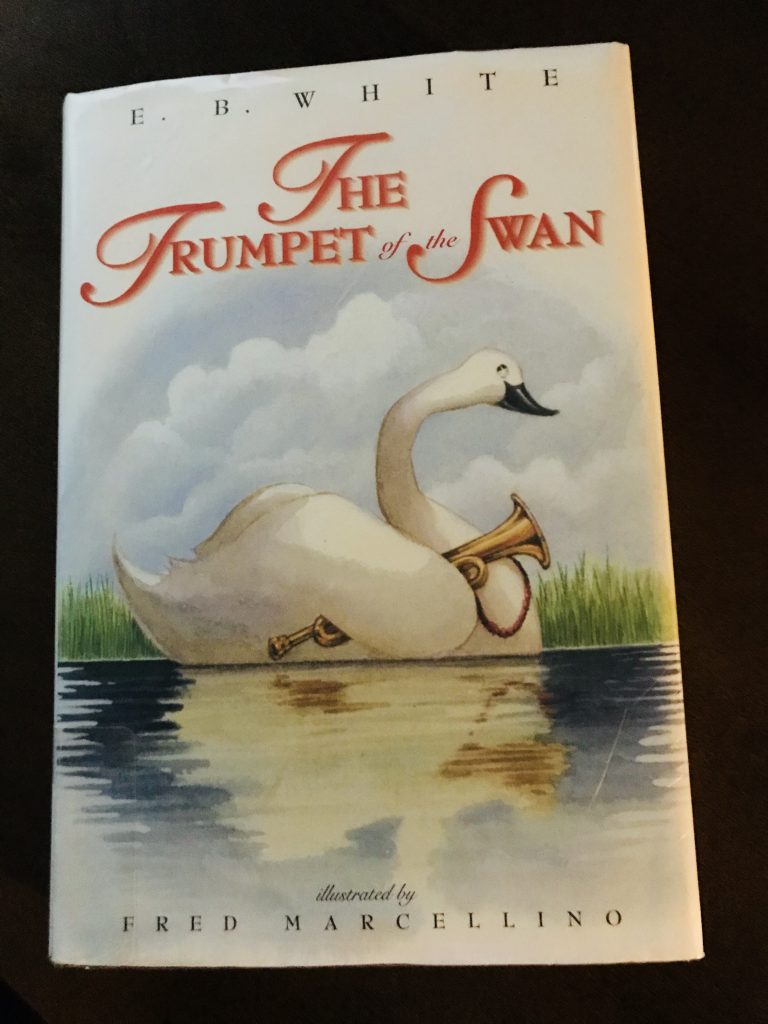
Can you believe it is September? Time to officially kick off our new Family Book Club!
This month our book is The Trumpet of the Swan by E.B. White.
Week 1
- There are 21 chapters in the book, so this week we will read the first 5 chapters.
- If you want to add more, check out the Big Questions section for discussion or freewriting prompts.
- If you want the full experience, pick an activity to reinforce and play with the story you are reading.
- If you prefer, you can save your favorite activities until the end of the book and celebrate with a party.
Ready?

Links are shown in italics.
Chapter 1
- Questions – Should Sam have told his Dad about the swans? When is it OK to keep a secret? Would you like to be in the wilderness like Sam?
- Activity 1 – Sam says the eggs should hatch in 35 days. You could verify the incubation period for swan’s eggs. You could check the incubation period for other birds – ducks, robins, etc. Make a chart if your child is excited about it.
- Activity 2 – Purchase, find or borrow a compass and learn how to use it. Take it in the yard and find each direction – north, south, east and west. Take the compass into your child’s bedroom and see what direction the window faces. Discuss the sun rising in the east and setting in the west.
- Activity 3 – Sam loved wildlife and studied about lots of animals and their habitats. Ask your kids if they would like to study a particular animal. Find a DVD at your library or a video online or a book and note three exciting facts about their favorite animal.
Chapter 2
- Question – How do birds know how to make nests, if they have never done it before?
- Activity 1 – The book says the cob’s wingspan is eight feet across. Pick an empty wall that you can stand against. Mark one end with a piece of masking tape. Measure eight feet and then mark the other end. Let each child spread their arms out to see how they measure against the cob. You can mark each person’s “wingspan” with different colors of post-it notes. Take their picture. Compare your size to the swan.
- Activity 2 – Make a nest using blankets. Try to keep it round and measure to make sure it is six feet across. Then pile as many people in the nest as you can and take a picture. If you have round pillows or footballs put those in the nest instead and see how full the nest would be with five “eggs”.
- Activity 3 – Here is more information on trumpeter swans from the Red Rock Lakes National Wildlife Refuge in Montana.
- Activity 4 – If it will not upset your children, make a list of predators. Several are listed in the book. You could print out photos of the animals you list and put a caption on the top of the page, like “Watch Out!”
- Activity 5 – You hear in the story that the male is called a cob. They are excited to meet their babies, called cygnets. The female is called a pen and a group of swans is a herd. Discuss or make a chart showing the names of other animals. The book lists other male animals: a bull, a rooster and a ram. You could just look up the female names to complete a small list. If your child is young, perhaps just go over baby animal names.
- Activity 6 – Watch a video of nest making. I saw this one last year and still remember it! The video can be of any type of nest making.
Chapter 3
- Questions – What is the longest you ever had to sit? What did you do to pass the time? Would you try to protect a nest of eggs? Why or why not? How do animals express their joy or love?
- Activity 1 – If you still have your blanket nest from yesterday, you could try to find objects that are five inches in length to represent the swan eggs. If you love doing crafts, pull out newspaper and form five egg shapes – about five inches in length. Make the paste and dip newspaper strips in the paste and then layer onto your egg shape. Continue while there is interest. You could finish laying the strips on the eggs another day. Once the eggs are completely dry, they can be painted. Ask your kids if they want to name the eggs. Don’t forget to name one Louis!
- Activity 2 – Start a nature journal for sketching or notes.
- Activity 3 – Sam wrote a few sentences in his journal every night. Try writing a few sentences tonight like Sam. Make sure you put the date on your entry.
- Activity 4 – Go on a nature walk. Use a scavenger hunt checklist if you are new to nature walks. This can help your children stay engaged in looking.
Chapter 4
- Questions – Why does the cob use so many words? Do you like to speak in fancy phrases or plainer words? Does the cob make you laugh? When you are cold, do you snuggle in with your mother, like the baby cygnets? How do you communicate if you have a sore throat?
- Activity 1 – If you have access to a pool that is still open, you could take your cygnets for a swim. Select one to be the cob and the rest to follow for a few minutes. Then pick another person to lead.
- Activity 2 – Put socks on and try “gliding swanlike”. Add some music, like Swan Lake, or another favorite piece, to make it more special. [Play it like a game of musical chairs: when the music stops, the kids have to stop gliding or they must go back in the nest (the sofa).]
- Activity 3 – Watch a video of swan eggs hatching.
- Activity 4 – Watch someone do sign language or check out a DVD and let the kids practice using their hands to talk.
Chapter 5
- Questions – How did you feel when the cob called Louis defective? What is a kind way to say that Louis has a challenge? What is something that challenges you? It could be tying your shoes, riding a bike without training wheels, or learning multiplication. How do you feel when you want to do something but can’t? What helps you overcome your frustration? Words like dumb, stupid or fat can hurt other people’s feelings. What are some words we could use instead? Maybe we could describe good things about the person instead. The lady with the beautiful brown eyes. The boy in the red shirt, who was a fast runner. Are people who are handicapped really defective or deficient? Does their weakness become their strength in time? Was Louis’ Dad right to want to get him a trumpet?
- Activity 1 – Watch kids who have overcome personal challenges. Try to do one or two everyday tasks without using one hand or one leg. How hard was it?
- Activity 2 – Watch a man who paints with his mouth. Try painting by holding the brush with your mouth or your toes.
- Activity 3 – Whatever you named as something that challenges you, work on that for a few minutes today. Tell yourself that you can overcome this challenge if you work at it. Practice makes progress!
That’s it for this week! If you are excited about this book club, please share the link on Facebook so that more people can see and join. Feel free to post pictures of your kids doing any of the activities or comment about any of your discussions. I would love to see them! Or post on Instagram using the hashtag: #theroadscholar
If you have questions, drop them in the comments and I will get right back to you!
Comments